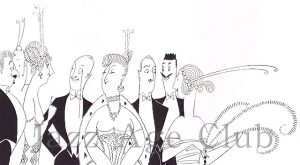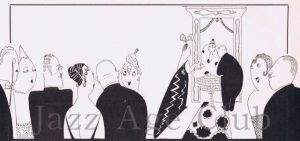The Social Season in the Jazz Age
The social season in the Jazz Age was a well established pattern of behavior where the elite, rich and famous members of society moved with the seasons like a flock of migratory birds from one nesting place to another enjoying a range of activities and events.

Fashionable society has always lived by a routine largely defined by the seasons hence perhaps the term ‘social season’. The roots of the concept, certainly in the UK, were linked to the movements of the royal family and certainly, by the 18th Century, they were in residence in London from April to July and from October until Christmas along with members of the aristocracy and the ruling classes. The Season traditionally began after Easter with the custom of returning to London at the end of the hunting season and ended with the ‘Glorious Twelfth’ (12th August), which was the start of the shooting season for red grouse.
The period was marked by high profile balls, galas, parties, sporting events, horse racing, debutante balls, dances, concerts and charity and other special events. One of the first social significant event was staged by George III, for example, who staged a May ball, to raise money for a new maternity hospital, named after his wife Queen Charlotte. It became an annual event, and the fulcrum of the social season at the time.
As a result a social calendar and ritual of events was established whereby the elite knew where they should be and what they needed to do. The season also became known for when well-bred girls were launched into society and the marriage market at the age of 17 or 18 with a formal introduction to the monarch and a debut at the high-profile ball.
Similar activities were followed all over Europe and America and, with the advent of the 20th century and foreign travel becoming more prevalent and fashionable, many of the elite established new patterns of engagement particularly with accepted sojourns on the Riviera in early spring and Deauville and other Normandy resorts in August.
However, the traditional season was interrupted by the First World War and thereafter it more became difficult to maintain social exclusivity. As a result, a slightly more flexible, more open, and more European model emerged and in the 1920s the social season was a far more complex and varied affair.

London’s season followed a set pattern with racing at Ascot in June, racing at Goodwood in July and the Cowes regatta in August. These events along with the more usual court functions, debutante balls, the craze for dancing, the growth of nightclubs and the evolution of smart cocktail parties spawned an ever increasing demand for luxurious garments, which gave rise to the growth of many new fashion houses in the 1920s and a set pattern emerged with each house giving two seasonal collections each year in March or April and in September or October. Equally, the new cabaret craze also followed a set season with openings and new shows in the spring and autumn with summer closings in town but dedicated venues for summer entertainment out of town.
In Europe, especially France, the season began with a visit to Saint-Moritz in January and then Cannes, Nice and Monte Carlo in February and March, Le Touquet at Easter, Paris in June for the horse racing, Deauville in August and Biarritz in September.
Paris, always a social magnet like London, had a busy summer season and throughout June there were numerous race meetings, which culminated in the Grand Steeplechase at Auteuil (21st June) and the Grand Prix at Longchamps (28th June). Both race courses were located within ten minutes of Paris in the Bois de Boulogne about a mile from each other, and become an institution. The races themselves were often eclipsed by the kaleidoscopic pictures of colourful fashions that paraded around the green lawns giving a sneak preview of the distinctive features that would dictate the autumn couture shows.
One of the most important events of the social season was the Bal du Grand Prix at the Opera on the night before the Grand Prix. After the races everyone trouped back to Paris, but many stopped for tea and dancing at one of the popular summer hot spots in the Bois de Bologne: l’Hermitage, Chateau de Madrid, the Pre Catalan or the Café d’Armenonville.
But things were not the same and the changes were more visible on the Riviera in the early part of the year. Many of the old breed of visitors had vanished. The Russian aristocracy, once the heaviest gamblers in Europe and lovers of Monte Carlo and its Casino, and the rich members of the German and Austro-Hungarian empires had been largely wiped out by war and revolution. Their places were taken by a new type of visitor, one that the old guard clearly despised – Americans! The growing numbers of freshly minted American millionaires, and others with lighter fortunes, flocked to Europe to avoid Prohibition and avail the benefits of an exceedingly good exchange rate. They particularly loved the horse racing in Paris and, although they tended to avoid Monte Carlo, with its more exotic atmosphere and its eccentric inhabitants dedicated to gambling, gravitated to the newer casinos at Nice and Cannes.
One disgruntled commentator said in 1921 ‘the Riviera is not what it was. It is different and it is not better. I am not concerned to maintain that is less attractive than the Spring of 1914, say, but it is certainly a very much less attractive, less amusing and less intimate place than it used to be 20 or more years ago. It has become democratic, for one thing and is has become much more moral.’
Americans also had a marked effect on changing the dictates of the season as Vogue observed ‘no longer is the American an innocent abroad, he not only follows but frequently sets the style… We always think of going to Europe in the summer, of Paris and London in May and June, but very shortly, there will be no ‘season’ for Europe, as there has always been before, because the sophisticated American had now discovered that the most charming time in Europe, especially for those who have friends there, is the off season.’
August was the height of the season for Deauville on the Normandy coast followed by Biarritz in September. Deauville was seen as act one and Biarritz as act two in a ‘comedy of extravagant pleasure.’ But, equally changes were afoot and other resorts like Ostend and Venice were gaining ground.
Although Ostende was a place to visit most of the spring and summer it was at the height of the season during June to August when it became a cosmopolitan assemblage of rank, fashion and beauty. Deauville, long the champion of society throughout August, soon learned that a visit to Ostend was needed before or after its season.

At the same time some felt that Deauville was losing its exclusivity and even becoming vulgar. It was felt that Deauville’s reputation was attracting too many sightseers and that Americans in particular crossed the Atlantic because they simply had to see Deauville or the ‘City of Spectacular Sin.’ As a result many of the social elite transferred their affections to the Lido in Venice described as ‘the Deauville of Italy.’ As Vogue said ‘even with the terrific popularity that Biarritz and Le Touquet have had, Venice can not be touched, for there is no such setting in the world.’
Of course another innovation had a major impact on the season – sunbathing and this was also largely due to American’s. In the early 1920s a group of Americans began to spend the summer on the Riviera. This was considered daring and very strange at the time since the Riviera season was a winter one and all the hotels closed from late spring all through the summer. Cole Porter decided to rent the Chateau de la Garoupe in Antibes for the summer of 1921 and invited friends to visit and had a grand time. The next the summer (in 1922) Gerald and Sara Murphy rented a whole floor in the Grand Hotel at Cap d’Antibes. Outside they created a beach by removing the seaweed to reveal the sand and dowsed themselves in banana oil and sunbathed. Within a few years the fad of sunbathing engulfed society and the Riviera became an all year round destination. By the late 1920s it was de rigeur to spend the summer not on the Normandy Coast or the Lido but the new elite Cote d’Azur beaches .
After World War II, society had become more egalitarian and the social season of the past gradually changed and, significantly, in recent years it has been largely eroded although some of the more high profile events still endure.
All images and text © copyright Gary Chapman / Jazz Age Club and must not be re-used without prior consent
[sources]
Sources:
Theatre World, Dancing Times, Variety, Vogue, Eve,
The Long Party by Stella Margetson
The Money Spinner, Monte Carlo and Its Fabled Casino by Xan Fielding
Further Reading
The London Season by Michelle Jean Hoppe
Debrett’s History of the Season
The London Season by Evangeline (Edwardian Promenade)
The New York Social Season by Evangeline (Edwardian Promenade)
[/sources]

What an informative article! I could never get the “Seasons” straight when reading American vs. European fiction, since writers like Edith Wharton, for instance, might be traipsing around Italy looking for castles, or later on, slogging through the Berkshires in Massachusetts, hobnobbing with…well, her own guests (it was bleak then!), whereas authors like Galsworthy almost always had their characters (as in “Jocelyn”) hanging around Monte Carlo then. It’s very confusing! Then there are the towns of Newport to Bar Harbor on the New England Coast, while other “new millionaires” from America were yachting around the Caribbean. I also found it funny that early on, so much of the season was based on hunting, as is mentioned in Austen’s “Sense and Sensibility”. The women are upset in London because the men are still off hunting!
I just discovered your website tonight–wow is about all I can say! I love this time period, so thank you for your lovely writing and all the research that has gone into this well-thought out post, and now I am going on to look at some of your other posts!